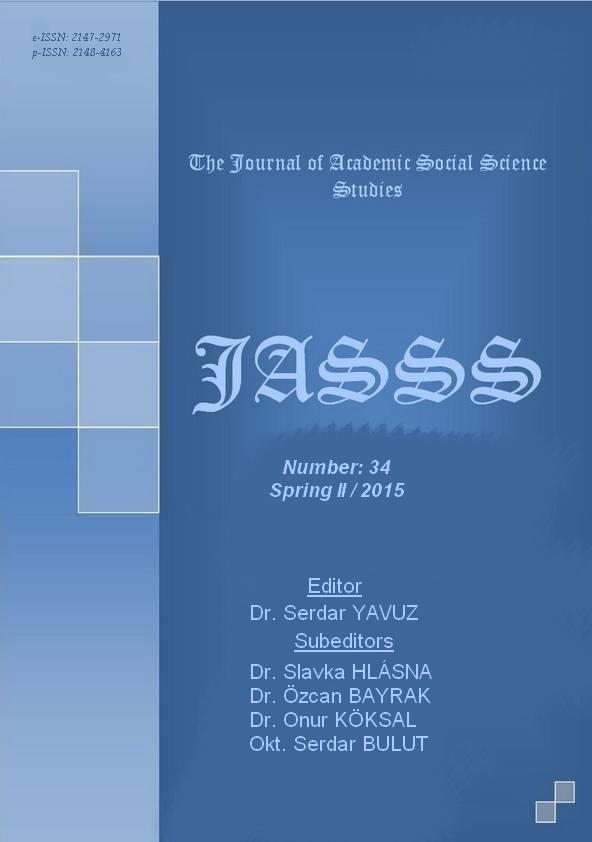Author :
Abstract
Bu araştırmanın amacı üniversite öğrencilerinin Hz Muhammed’e İlişkin algılarını metaforlar aracılığıyla ortaya çıkarmaktır. Araştırmanın çalışma grubunu, 2014-2015 eğitim öğretim yılında Gümüşhane Üniversitesinin İlahiyat Fakültesi ve Sosyal Hizmetler bölümlerinde öğrenim gören toplam 194 katılımcı oluşturmaktadır. Araştırma tarama modelinde betimsel bir çalışmadır. Araştırma verileri, “Hz Muhammed……gibidir, çünkü……” cümlesini içeren bir form aracılığıyla toplanmıştır. Verilerin analizi ve yorumlanmasında içerik analizi tekniği kullanılmıştır. Araştırmanın sonuçlarına göre; katılımcıların Hz Muhammed’e İlişkin 53 farklı metafor geliştirdikleri ve bu metaforların 9 kategoride toplandığı görülmüştür. Katılımcıların Hz Muhammed’e ilişkin ürettikleri metaforlardan ‘yol gösterici’, ‘örnek’, ‘aydınlatıcı’, ‘önder’, ‘duygusal niteleme’, ‘öğretici’, ‘kurtarıcı’, ‘anahtar’ ve ‘diğer’ metafor kategorileri oluşturulmuştur. Araştırma sonucuna göre Hz Muhammed’e ilişkin metaforların ‘yol gösterici’, ‘örnek’ ve ‘aydınlatıcı’ kategorilerinde yoğunlaştığı görülmüştür. Demografik değişkenler ile kategori ilişkisine bakıldığında fakülte değişkeni açısından İlahiyat öğrencileri ‘örnek’, ‘aydınlatıcı’ ve ‘öğretici’ kategorilerinde daha fazla metafor üretirken sosyal hizmet öğrencileri ‘önder’ ve ‘diğer’ kategorilerinde daha fazla metafor ürettiği anlaşılmaktadır. Cinsiyete göre kız öğrenciler ‘örnek’ kategorisinde daha fazla metafor üretirken erkek öğrenciler ‘öğretici’ kategorisinde daha fazla metafor üretmişlerdir. Lise mezuniyet durumuna göre İHL’den mezun olanlar ‘yol gösterici’ ve ‘aydınlatıcı’ kategorilerinde daha fazla metafor üretirken diğer lise mezunları ‘örnek’ kategorisinde daha fazla metafor üretmişlerdir. Öznel dindarlık algısına göre ise az dindar olduğunu düşünenler ‘aydınlatıcı’ ve ‘duygusal niteleme’ kategorilerinde daha fazla metafor üretirken kendisini dindar olarak görenler ‘örnek’ kategorisinde daha fazla metafor üretmişlerdir.
Keywords
Abstract
The aim of this study was to reveal perceptions regarding the concepts of Prophet Mohammad of university students’ by metaphors. The research study was carried out at the 2014-2015 academic year with 194 university students who educating at the Theology Faculty and Social Service Department at the Gümüşhane University. The study is a descriptive research in the survey model. The study’s datas were gathered through a form which included phrases like “Prophet Mohammed is similar …, because...”. The analysis and interpretation of data were used content analysis techniques. Results of this study showed that 53 metaphors were developed regarding the concept of Prophet Mohammed that these metaphors gathered under 9 categories. Metaphor categories were created ‘guide’, ‘specimen’, ‘enlightener’, ‘leader’, ‘emotional qualification’, ‘instructive’, ‘savior’, ‘key’ and ‘other’ from metaphors were developed perceptions regarding to Prophet Mohammed. According to the results, metaphors regarding to Prophet Mohammed, more in number was obtained in the ‘guide’, ‘specimen’ and ‘enlightener’ categories. In the analysis relationship between demographic variables and categories, according to faculty variable, theology faculty students developed more metaphor in the ‘specimen’, ‘enlightener’ and ‘instructive’ categories. According to sexuality variable, male students developed more metaphor in the ‘instructive’ category while female students developed more metaphor in the ‘specimen’ category. According to high-school graduation case, graduated other high-school students developed more metaphor in the ‘specimen’ category, while graduated from religious vocational high-school students developed more metaphor in the ‘guide’ and ‘enlightener’ categories. According to subjective religiosity perception, persons that accepted as religious developed more metaphor in the ‘specimen’ category, while persons that accepted as low religious developed more metaphor in the ‘enlightener’ and ‘emotional qualification’ categories.





